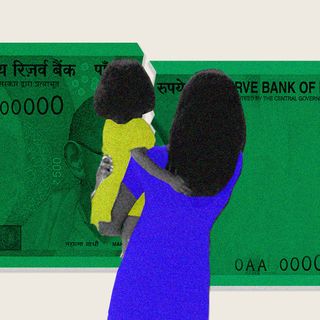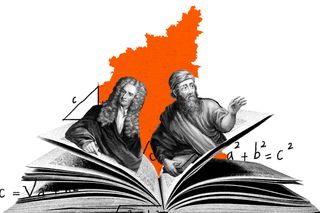
Karnataka’s New Education Proposal Calls Pythagoras Theorem, Newton’s Law ‘Fake News’
The proposed recommendations claim Pythagoras and calculus have Vedic roots, and thus “communicate to our students’ such details of our lofty past.”

Many moons ago Isaac Newton formulated the gravitational theory. This is one of the most famous stories in the canon of scientific discovery; Newton reportedly observed an apple fall to the ground (or in some versions the apple falls on his head, too) which led him to articulate the law of gravitation that is the foundation of physics as we know it.
But this is “fake news,” according to the Karnataka government. In a recent proposal regarding the curriculum in its syllabus under the National Education Policy (NEP), the government said that Newton’s Law, and even the Pythagoras theorem in Maths, are fake news that the West has “created and propagated,” according to reports. The Union government is currently developing a revamped syllabus under the NEP, for which inputs from other state governments will be considered for shaping India’s new education curriculum.
One element of the proposal calls into question the “Eurocentric” lens of the curriculum. The proposal notes that things like gravity and Pythagoras are rooted in “Vedic Maths” and wants to promote an “India-centered approach” to education. The paper argued that the current education system for “ignoring achievements of their own ancestors,” according to a Times of India report. Children should be able to juxtapose “mathematical concepts which have its origins in Europe” with concepts from “ancient Bharat,” what it also calls Bharatiya Geometry. One example of the latter would be introducing some sutras of Vedic mathematics — for “fast mental calculation.” In other words, the proposal effectively claims that something like the Pythagoras theorem — named for the Greek philosopher who formulated it — has Vedic roots. Even calculus originated in medieval India, the recommendations stated.
“For instance, it is believed that Baudhayan [ancient Indian mathematician] had laid down Pythagoras’ theorem in Vedic texts,” said Madan Gopal, chairman of the task force for Karnataka’s primary and secondary education department. “This is a viewpoint. You may or may not agree with it.”
Pythagoras theorem is a staple of high school mathematics; the law goes that the sum of the squares of the sides of a right-angled triangle is equal to the square of the hypotenuse. The technique is widely used in engineering and construction fields too. Moreover, gravity, and Newton’s laws of motion, have become the rudimentary blocks of physics.
Yet, the government puts the credibility of similar scientific and mathematical theories into question. This is purportedly in a bid to “[E]ncouraging an attitude of questioning and not merely accepting whatever the textbooks (or print/electronic/social media) say as infallible truth, with a clear foundation of how knowledge generation takes place and how fake news such as Pythagoras theorem, apple falling on Newton’s head etc. are created and propagated,” according to Karnataka’s position paper.
Related on The Swaddle:
History Books Should Include Vedas, Bhagavad Gita for ‘Unbiased’ Education: Govt Panel
Another recommendation, again, is to shift the focus to Indian-centric literature from the West to remove the faces of Greek mathematicians Pythagoras and Heron. “It is also recommended that some of the examples given in the textbooks on Bhāratiya geometry can be done outside the classroom, probably in the playground. Sections on Greek mathematics need to be trimmed down, especially the depictions of the faces of ‘Greek mathematicians’ such as Pythagoras, Heron, etc.,” reads the proposal.
The objective appears to be to uphold ancient Indian frameworks of education, ones that link to the Rig Vedic period. For it is these claims and suggestions that “communicate to our students such details of our lofty past.” This part betrays much of the intent around making India-based amends to the curriculum: with the learning objective anchored around sanitizing India’s legacy.
While the state government’s input wants students to question established knowledge systems by virtue of them being Western, it also desires the inclusion of some contentious literature. One such example is the Manusmriti, which scholars have long criticized for its casteist ideology, one that dehumanizes people along caste, class, ethnicity, and gender lines. It “sums up Brahmanic ideology in the starkest term,” as the News Minute noted. Other recommendations include teaching Sanskrit as a third language and ancient numeral systems like Bhutasankhya (method of recording numbers in Sanskrit using common nouns) and kaṭapayadi sankhya to all school children.
None of this can be understood in totality without placing the recommendations within Karnataka’s current socio-political climate. Over the last few months, the Rohit Chakrathirtha-led textbook revision committee has proposed several contested additions and deletions as part of the state’s primary and secondary education. The panel dropped references to prominent historical personalities and instead included controversial figures, sparking protests across the state as critics pointed out the veritable “saffronizing” of school education.
The ideological polarizing is not only reflected in terms of violence and hostility, but may also embed itself in the very knowledge ecosystem as India is writing and re-writing much of what children will learn. The project of protecting “India’s traditional knowledge” is thus dictating what our education framework should look like.
A government panel last year similarly proposed contentious recommendations to India’s history books. As The Swaddle noted back then: “It is no surprise that most histories in the world are written, and rewritten, with a bias towards the prevailing victors. But relentless conflating truth, history, and glory appear to solidify a worrying narrative — one that is far from being accurate.”
Saumya Kalia is an Associate Editor at The Swaddle. Her journalism and writing explore issues of social justice, digital sub-cultures, media ecosystem, literature, and memory as they cut across socio-cultural periods. You can reach her at @Saumya_Kalia.
Related


We Asked Single Women What It’s Like to Look for Houses in India. These Are Their Stories.
